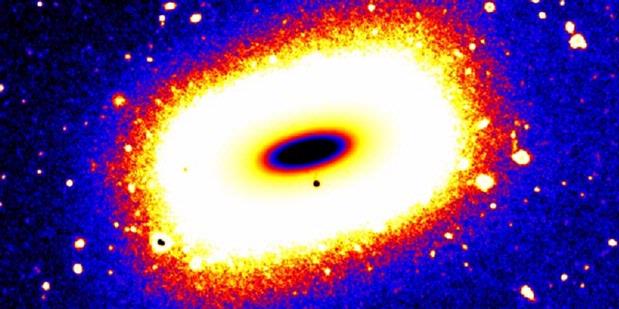MELBOURNE - Astronomers discover galaxy LEDA 074 886 uniquely named. Tablet-shaped galaxy, has a corner tub or iPad tablet medication.
LEDA is located at a distance of 70 074 886 light years from Earth in the constellation Eridanus precisely. This galaxy was found by observation with Subaru teleksop in Hawaii.
Alister Graham from the Swinburne University of Technology in Australia, the inventor of this galaxy astronomers, said: "At first I think this is a mistake. But eventually I could not stop smiling."
Most of the disc-shaped galaxy with spiral, elliptical or irregular. In tablet form, this galaxy is an anomaly.
Graham said that the galaxy is located at the edge of another, more massive galaxy, called NGC 1407. This tablet galaxies 50 times fainter than the Milky Way. Naturally, if the existence of long undetected.
According to Graham, the galaxy of this tablet is a combination of two spiral galaxies. When joined, the pivot point of the two galaxies forming galaxies tablet.
074 886 galaxies LEDA is a hybrid because it has characteristics of two merging galaxies.
In theory, elliptical galaxies tend to be poor star-forming material. Computer simulations will show that when two elliptical galaxies merge, the galaxies formed beam with minimal stellar activity.
Contrast to elliptical galaxies, the model shows that galaxies with star-forming gas that many would not be a tablet if the galaxy merger and have a high star activity.
LEDA 074 886 unique because in addition to having the form of tablets, star activity was also detected in the dishes. This uniqueness will help astronomers to develop models of galaxy mergers is more complex.
Ben More, an expert in theoretical physics from the University of Zurich are also involved in research, will develop a model of the formation of the LEDA 074 886 supercomputers this year.
Graham, as quoted by National Geographic, Tuesday (20/03/2012), said that the model would predict age tablet form.
According to Graham, but could 074 886 LEDA galaxy merger with the right, its tablet form will disappear in a few billion years.
Graham and his colleagues study results will be published in the Astrophysical Journal.
LEDA is located at a distance of 70 074 886 light years from Earth in the constellation Eridanus precisely. This galaxy was found by observation with Subaru teleksop in Hawaii.
Alister Graham from the Swinburne University of Technology in Australia, the inventor of this galaxy astronomers, said: "At first I think this is a mistake. But eventually I could not stop smiling."
Most of the disc-shaped galaxy with spiral, elliptical or irregular. In tablet form, this galaxy is an anomaly.
Graham said that the galaxy is located at the edge of another, more massive galaxy, called NGC 1407. This tablet galaxies 50 times fainter than the Milky Way. Naturally, if the existence of long undetected.
According to Graham, the galaxy of this tablet is a combination of two spiral galaxies. When joined, the pivot point of the two galaxies forming galaxies tablet.
074 886 galaxies LEDA is a hybrid because it has characteristics of two merging galaxies.
In theory, elliptical galaxies tend to be poor star-forming material. Computer simulations will show that when two elliptical galaxies merge, the galaxies formed beam with minimal stellar activity.
Contrast to elliptical galaxies, the model shows that galaxies with star-forming gas that many would not be a tablet if the galaxy merger and have a high star activity.
LEDA 074 886 unique because in addition to having the form of tablets, star activity was also detected in the dishes. This uniqueness will help astronomers to develop models of galaxy mergers is more complex.
Ben More, an expert in theoretical physics from the University of Zurich are also involved in research, will develop a model of the formation of the LEDA 074 886 supercomputers this year.
Graham, as quoted by National Geographic, Tuesday (20/03/2012), said that the model would predict age tablet form.
According to Graham, but could 074 886 LEDA galaxy merger with the right, its tablet form will disappear in a few billion years.
Graham and his colleagues study results will be published in the Astrophysical Journal.
source : kompas.com

